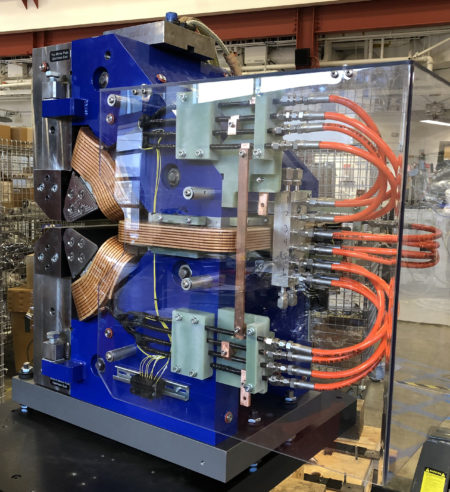by Lori Tamura
It’s been a busy summer at the ALS, with developments ranging from the delivery of a new prototype magnet for testing, to the refurbishing of the Building 80 cubicle farm and lounge area. A five-week shutdown checked off several important upgrades and installations, while other Building 6–related projects proceeded in parallel.

An unusual new species of storage-ring magnet was spotted in the Building 15 high bay. It’s a prototype of a hybrid dipole/quadrupole design for the ALS Upgrade (ALS-U) Project, here for testing by Chuck Swenson and members of the ALS Magnetic Systems Group. In the storage ring, dipole magnets are primarily used to bend the electron beam (orbit correction), while quadrupoles primarily focus the beam. The striking asymmetric configuration of the poles in the hybrid magnet reflects its dual function: it has four poles like a quadrupole, but two of them are stacked vertically, as in a dipole. Plans are to eventually incorporate seven of these hybrid magnets in each sector of the ALS-U storage-ring lattice.
Another type of upgrade is currently underway in ALS-adjacent Building 80, which has been overdue for a face lift for many years. The old cubicle farm outside the control room was completely stripped out, down to the concrete floor. Brand-new furniture has been installed, including partitions, sit-stand desks, ergonomic chairs, shelving, and cabinetry. The refurbished space will be able to accommodate twice the number of people as before—including areas for short-term drop-ins—and will help make up for seats that will be lost when Building 7 is torn down.

The critical-path driver of the five-week shutdown was a project to relocate safety cabling used for top-off mode. The cables were previously located in a wireway that will eventually have to be removed to accommodate the ALS-U accumulator ring. Other projects included the installation of four fast-corrector vacuum chambers for faster feedback on beam stability, upgraded controls on the insertion device for Beamline 4.0.2, routine replacement of the klystron in the linac, and other small beamline tasks such as cleaning and inspections. Concurrent with the shutdown, work was begun to fix a persistent problem with flooding near Sector 4 during periods of heavy rain. A storm drain that was backing up was jackhammered out of four feet of concrete and replaced.
This summer has seen a spate of days with unusually high temperatures, and in addition to HVAC improvements in the ALS complex, efforts have been underway to improve thermal stability on the experiment floor. A computer model of the air flow dynamics in the ALS showed dramatically how warm air currents concentrate under the dome. The model was used to guide the process of revamping how air temperature is controlled on the floor. The system is still being tuned, but it has resulted in an overall improvement in thermal stability and energy efficiency.
